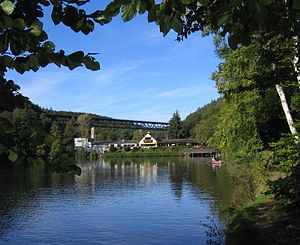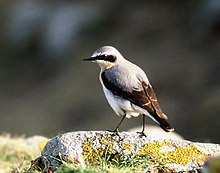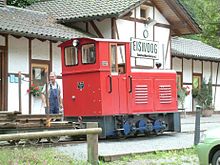Eiswoog
| Eiswoog | |||||||||
|---|---|---|---|---|---|---|---|---|---|
| From the front: Eiswoog, dam wall with hotel, Eistal viaduct | |||||||||
|
|||||||||
|
|
|||||||||
| Coordinates | 49 ° 30 '46 " N , 7 ° 58' 55" E | ||||||||
| Data on the structure | |||||||||
| Height of the structure crown: | 250 m above sea level NHN | ||||||||
| Crown length: | 120 m | ||||||||
| Data on the reservoir | |||||||||
| Altitude (at congestion destination ) | 247.8 m above sea level NHN | ||||||||
| Water surface | 2.7 ha | ||||||||
| Reservoir length | 410 m | ||||||||
| Reservoir width | 150 m | ||||||||
The Eiswoog is an approximately 2.7 hectare reservoir of the Eisbach , which is regionally also called the Eis , in Rhineland-Palatinate . The lake extends from south to north in the valley floodplain of the stream near the source in a part of the northern Palatinate Forest , the stump forest .
geography
The Eisbach, a left tributary of the Rhine , at 347.8 m above sea level is southwest of the local community of Ramsen . NHN dammed into a woog near its seven source streams . Thus, in southwestern Germany called natural or artificial lakes that used to store water for mills and hammer mills or as a gathering place for the drift served by Scheit- or timber.
history
The name "Eiswoog" means "reservoir of the ice". For the designation of the flowing water, see there .
Originally the Eiswoog was probably a naturally created lake. Presumably, this lake began to be dammed up in the Middle Ages. Today it extends beyond its main area up to 200 m into the confluence of the main tributary Eisbach and the most water-rich tributaries Hollerbach and Habersbach.
Stumpfwald and Eiswoog belonged to the Ramsen nunnery founded in 1146 . It is known that the nuns had reservoirs built as fishing waters in several of the surrounding valleys. The Eiswoog also served as a fish pond. After the monastery was dissolved, the properties came to the Worms Monastery and the Counts of Nassau . The Eiswoog belonged to the Nassau-Weilburg rulership in the 18th century . In 1812 the ironworks owner Ludwig Gienanth acquired the "Eisenwoog", which was expropriated as a national property, in order to secure the hydropower supply of his operations on the Eisbach near and in Eisenberg even in dry periods by expanding this water reservoir . The dam of the Eiswoog was raised and strengthened in the following years, thus expanding the water surface to its present size. Twice it came to severe storms at a fraction of the dam: In the night of 12 to 13 April 1819, the flooding continued Ramsen underwater, and on August 4, 1875 flooded the waters Ramsen and lying on the Eisbach districts of Eisenberg and damaged factories and mills.
A pond keeper's house was built on the north side of the dam in 1832 and a hunting lodge was built on the dam in 1876. The Stumpfwaldstraße, now L 395, which runs past the Eiswoog, was laid out in 1839–1843. The Eistal Viaduct was completed in 1932. Around 1900 a fish farm was set up below the dam . When the railway bridge was bombed in 1944, the viaduct was only slightly damaged, but the pond keeper's house and the hunting lodge were destroyed. The hotel-restaurant "Seehaus Forelle", which today stands on the top of the dam, was built in 1950/51 by Ulrich von Gienanth. The Eiswoog is still owned by the von Gienanth family to this day.
investment
commercial use
The hotel restaurant on the dam wall also provides rowing boats. There are 14 managed fish ponds below the reservoir. The Eiswoog itself is also used for fish farming. In winter, its water is usually drained so that maintenance work can be carried out.
Nature discovery trail
The area around the Eiswoog is a hiking area that offers easy to challenging routes. A 3 km long hiking trail leads around the lake. In a model project of the University of Kaiserslautern , part of the path and the facilities around the lake have been redesigned into a barrier-free nature experience path . The aim of the project was to make the viewing platform, bank access and a panoramic path accessible to people with visual and mobility impairments and to enable use with prams. The second construction phase was completed in 2009 and the nature discovery trail was inaugurated on August 25th by the Rhineland-Palatinate Environment Minister Margit Conrad . The entire project cost 325,000 euros, of which the state contributed 295,000 euros.
fauna
Trout , perch , pike and char can be found in the Eiswoog . The water is privately owned, so fishing is prohibited.
Gray Heron , pipes and little bittern and ducks , geese and swans are often found on Eiswoog, osprey against it only occasionally. The kingfisher , a strictly protected species , also nests at the lake . The wheatear , which is rare in Germany , has been registered as a migrant .
Eistal and Stumpwaldbahn
The current terminus of the Eistalbahn , reactivated for tourism reasons , the Eiswoog stop , is only served on weekends. To the north of the dam, the railway line, which was later closed to the west, crosses the Eistal on the Eistal Viaduct. The bridge was in operation until 1988. It is 35 meters high and, at 250 meters, is the longest railway bridge in the Palatinate . At its eastern end there is a worthwhile lookout point.
On a narrow-gauge line with a gauge of 600 mm, which runs roughly parallel to the Eistalbahn, a museum railway, the Stumpfwaldbahn , runs between Ramsen and the Eiswoog at certain times . It owns open cars and is a tourist attraction.
Transport links
North above the Eiswoog, the state road 395, which connects Eisenberg in the east with Enkenbach-Alsenborn in the west, with the Barbarossa cycle path passes. The cities of Kaiserslautern in the south-west and Grünstadt in the north-east are both reached after around 15 km via the L 395 . In addition, the Eistalbahn has ended in excursion traffic near the viaduct of the same name since 2001 .
literature
- Georg Spieß: The Eiswoog through the ages . In: North Palatinate History Association (Hrsg.): North Palatinate History Sheets . Volume 82. Rockenhausen 2002, p. 49-53 .
- Marion Hoensbroech-Gienanth: Making quality of life tangible and conscious: Overall concept Eiswoog - ecology combined with culture . In: Donnersbergkreis (ed.): Donnersberg yearbook . Volume 23. Kirchheimbolanden 2000, p. 180-185 .
Web links
Individual evidence
- ↑ a b Map service of the landscape information system of the Rhineland-Palatinate Nature Conservation Administration (LANIS map) ( notes )
- ↑ The Benedictine Ramsen changed in 1267 to stricter Cistercian Order , whose rule banned the consumption of meat, but allowed fish dishes.
- ↑ Georg Spieß: The Eiswoog through the ages. In: North Palatinate history sheets. Vol. 82, 2002, p. 49 f.
- ^ Carl Albert Buchheit: Secularization and expropriation of the goods of secular princes in the French Revolution in Bavaria (Palatinate) on the left bank of the Rhine. Speyer 1933, p. 170.
- ↑ Wolfgang Schieder (Ed.): Secularization and Mediatization in the Four Rhenish Departments 1803-1813. Part 4 Donnersberg Department , Boppard 1991, Ser. No. 10466, p. 156.
- ↑ Georg Spieß: The Eiswoog through the ages. In: North Palatinate history sheets. Vol. 82, 2002, pp. 50-53.
- ^ Die Rheinpfalz , Ludwigshafen: Barrier-free nature adventure trail , August 26, 2009.
- ↑ See discussion Eisbach: Observations in autumn 2004
- ↑ Free time. Seehaus Forelle Häckenhaus, accessed on January 4, 2012 .






